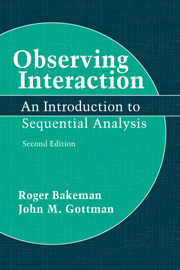Book contents
- Frontmatter
- Contents
- Preface to the second edition
- Preface to the first edition
- 1 Introduction
- 2 Developing a coding scheme
- 3 Recording behavioral sequences
- 4 Assessing observer agreement
- 5 Representing observational data
- 6 Analyzing sequential data: First steps
- 7 Analyzing event sequences
- 8 Issues in sequential analysis
- 9 Analyzing time sequences
- 10 Analyzing cross-classified events
- 11 Epilogue
- Appendix: A Pascal program to compute kappa and weighted kappa
- References
- Index
9 - Analyzing time sequences
Published online by Cambridge University Press: 13 October 2009
- Frontmatter
- Contents
- Preface to the second edition
- Preface to the first edition
- 1 Introduction
- 2 Developing a coding scheme
- 3 Recording behavioral sequences
- 4 Assessing observer agreement
- 5 Representing observational data
- 6 Analyzing sequential data: First steps
- 7 Analyzing event sequences
- 8 Issues in sequential analysis
- 9 Analyzing time sequences
- 10 Analyzing cross-classified events
- 11 Epilogue
- Appendix: A Pascal program to compute kappa and weighted kappa
- References
- Index
Summary
The tyranny of time
Events unfold in time. What distinguishes users of sequential analysis from many other researchers is that they attempt to move beyond this banal observation and try to capture aspects of this unfolding in quantifiable ways. For such purposes, it is often sufficient to know just the order of events, and to use the techniques for analyzing event sequences discussed in chapter 7.
Often, however, we want to know more than just the order of events. We want to know in addition how people (dyads, animals, etc.) spent their time. For that reason, it is common for investigators to record not just the order of events, but their times as well. In chapter 3 we described three ways such time information could be recorded (timing onsets and offsets, timing pattern changes, interval recording), and in chapter 5 we described three ways data could be represented preserving time (state sequences, timed-event sequences, interval sequences). Once recorded and represented, however, sometimes time information exerts a tyrannical hold on investigators who then seem reluctant to omit time from their analyses, even when this would be appropriate.
For many studies, especially when behavioral states are coded, we think time is worth recording primarily because “time-budget” information (amounts or percentages of time devoted to different kinds of events or behavioral states) has such descriptive value. For example, Bakeman and Adamson (1984), in their study of infants' attention to objects and people, recorded onset times for behavioral states, represented these data as state sequences, and computed and reported percentages of time devoted to the various behavioral states when with different partners (mothers or peers) at different ages.
- Type
- Chapter
- Information
- Observing InteractionAn Introduction to Sequential Analysis, pp. 150 - 176Publisher: Cambridge University PressPrint publication year: 1997
- 1
- Cited by



